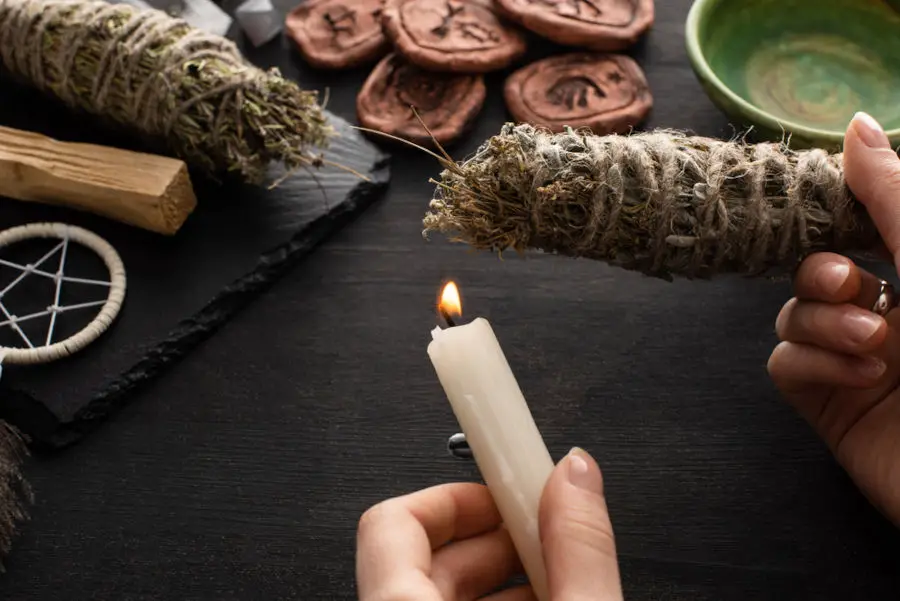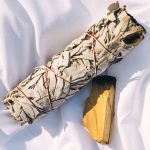Smudging is a traditional ceremony for purifying and cleansing using smoke from sacred plant material, usually herbs, flowers, and even trees and shrubs. Smudge is both a verb and a noun, as the bundle of the plant material is also known as a smudge. You can smudge a place, a building, an object, and even a person or group of people.
Smudging aims to remove the negative energy around a person, a place, or an object through the smoke released by burning the smudge sticks, which brings in positive energy. You can have mantras or prayers as you smudge, and the whole process increases the positive vibrations. This result creates room for healing, purification, and other positive effects of smudging.
There are four elements involved in a smudge with the container, usually a shell, signifying water as the first element. The plant material, often a combination of several sacred herbs, is taken as gifts from mother nature, representing the earth. The fire you use for lighting elements represents the third element, and finally, the smoke from the fire stands for air, the fourth element.
Where did smudging Originate from?
Smudging is an ancient tradition with archaeological findings showing the use of incense burners from as early as 4500 years ago. The word smudge comes from ‘smogen,’ a Middle Ages English word. Many cultures worldwide practice or have practiced a form of cleansing using sacred herbs, especially sage, myrrh, and frankincense. It is present even in modern religion through the burning of incense for blessing and purification and in shamanic rituals.
However, much of the modern-day practice, especially in New Age religion and home uses, traces its roots from Native Northern American cultures who have set protocols and ceremonies of how to do it and the various purposes and occasions for smudging. Most modern use of the practice currently is based on a loose interpretation of these but styled to a person’s preferences and their influences.
What Are the Benefits of Smudging?
Smudging provides the following benefits;
It helps purify the environment
A number of the herbs used in smudging have antibacterial properties. Sage variants, especially white sage and prairie sage, have antimicrobial and antibacterial properties which help keep bacteria, fungi, and viruses away from your home. Most of the other herbs and trees are also insect repellent.
Smudging can provide relief for people with respiratory diseases.
While more research is needed on this, burning sage during smudging is believed to release negative ions in the air. These ions help neutralize positive ions that are often found in allergens like pollution, dust, mold, and pet dander. As such, smudging helps people who are struggling with conditions like bronchitis, allergies, and asthma.
It enhances your spiritual well-being.
Smudging helps you to achieve a deeper spiritual connection and enhances your intuition. Traditional healers and shamans have long used smudging and burning of incense to achieve a healing state or get in a trance-like state that allows them to reflect deeper into issues.
It can help you to get connected both with your inner self and the energies around you. Some of the plant sticks being burnt contain thujone, which science shows is mildly psychoactive and could contribute to the experiences.
It can help you purify new and unfamiliar objects.
It is possible to smudge specific objects, and this is helpful when you are buying items or you receive gifts and other unfamiliar objects. If the object’s history or the energy around it concerns you, you can smudge the object without necessarily having to smudge the whole house.
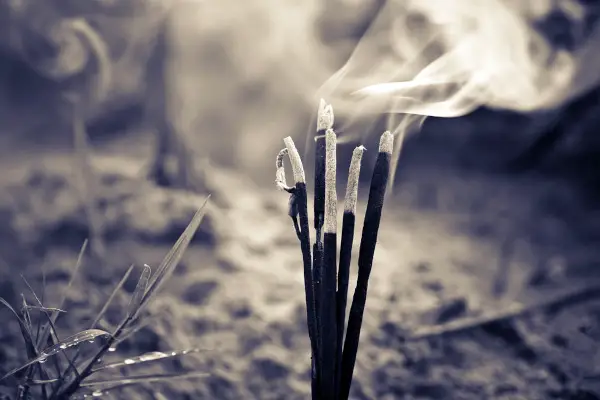
It can help improve your mood.
Smudging can be an excellent help in managing your moods. By getting rid of the negative energy around your house on your person, it lifts your spirits too. This impact makes smudging helpful in managing mood disorders and anxiety disorders.
It can help manage stress and depression.
Besides lifting up your mood, a smudging ritual can also help you alleviate stress and depression. There is scientific evidence to support this too. According to a 2016 study conducted for the University of Mississippi, some smudging plants like white sage contain compounds that act on the brain receptors responsible for improving mood and reducing stress.
It helps provide better sleep.
Smudging has long been used traditionally to promote better sleep. It does this by eradicating the negative energy and purifying the room. As such, it removes any irritants and distractions. Some varieties of sage could also contain compounds that soothe anxiety and manage insomnia.
It can help boost your energy levels.
Introducing newer and fresher energy around you has the effect of energizing you too. This smudging effect can be used to combat the effect of mental and physical fatigue. The various smudge sticks have also been shown to have compounds that boost the production of the serotonin hormone, which improves your moods and helps relieve fatigue.
It could help with your cognitive abilities.
Besides helping alleviate and manage your stress, depression, and anxieties, smudging has the overall effect of boosting your cognition. It helps sharpen your memory and focus and thus enhances your cognitive functions.
It leaves a nice fragrance.
Most of the plants your burn during the ritual have a rich aroma that is not only uplifting but also helps remove any odors. Sage, for instance, has a sweet fragrance which makes it an effective homemade chemical-free air freshener and odor remover.
Negative Effects of Smudging
Smudging involved burning, and because of this, it brings with it the negative effects associated with burning of anything. People with respiratory conditions are more susceptible to these effects and should only get in the rooms after the smoke is gone.
If you are in a prolonged ritual or frequently engaged in smudging and in areas with poor ventilation, or you do it with windows closed, you risk the following negative effects;
- Some of the smudging sticks, when burnt, release carcinogenic compounds similar to those found in cigarettes. If inhaled for long, they can cause health complications.
- It can aggravate respiratory conditions and their symptoms like asthma, environmental allergies, and lung issues.
- Smudging can release several pollutants like Sulfur Dioxide, Nitric Oxide, and Carbon Monoxide in high amounts that could affect your health.
- There is a risk that prolonged exposure to some of the compounds can exacerbate conditions like heart diseases and increase cancer risk.
- Children are more susceptible to the harmful effects of the compounds released during smudging, which could affect their development if they are exposed to high amounts for long periods.
How to Make Smudge Sticks
Smudge sticks are a critical part of the whole process, and you can make them from leaves, branches, or flower buds. Here is a straightforward way to make one.
- Choose several pieces of the plant material you want to use for smudging and cut them into pieces of about seven to ten inches.
- Measure a plant cord or twine that should be about four times the length of the cut smudge plant material.
- Bundle the material together to your preferred thickness. Hold it with the top facing down and wrap the cord tightly around the base so that it stays in place even after the plant material has dried.
- From the base, work your ways tying up to the tip and then back again until you get to the base. Then tie together the two ends of the cord at the base of the smudge stick.
- You can then trim any popping edges for a neat look and then leave the smudge to dry for one to two weeks, and your smudge stick will be set to go.
Related Reading: Herbal Magick – An Easy Form of Magick for Everyone – Opens in new tab
Smudging Herbs List
There are various herbs, trees, and shrubs one can use for smudging. One can use any though most adherents of the practice have specific herbs for specific purposes or seasons. Some of these herbs are readily available in the wild, while some will need garden cultivation. Some of the popular options are;
| Bay leaf (Laurus nobilis) | It has plenty of magical uses, including to banish or expel, for protection, to attain psychic powers, and divination. |
| Coltsfoot (Tussilago farfara) | It is associated with sun work and spring activities, and it is used in divination, and the leaf can also hold other smudge ingredients. |
| Eucalyptus (Eucalyptus spp.) | It is used for healing, protection, and clearing work. It has a nice scent and blends well with lavender and sage. |
| Hyssop (Hyssopus officinalis) | You can use this for purification and drive away negativity. It has a nice smell when burned. |
| Lavender (Lavandula spp.) | Lavender helps when you want relaxation, focus, and clear thinking. You can use both its flower heads and leaf stalks. Lavender combines well with sage and sweetgrass. |
| Lemongrass (Cymbopogon) | You use lemongrass for purification work and cleansing. It also helps remove obstacles and open doors. |
| Mugwort (Artemisia vulgaris) | Mugwort helps sharpen mental focus and also for a dream journey and trance activities. Others also use it to enhance psychic abilities. |
| Rosemary (Rosmarinus officinalis) | It serves as a protective and clearing herb, and it helps remove negative energies that often cause sickness. |
| Sage (Salvia spp.) | Sage generally serves as cleansing, purification, and clearing herb. There are several species that all have the same function but different scents. Popular options include white sage, garden sage, desert sage, and clary sage. |
| Scented Geranium (Pelargonium Spp.) | It serves for love, happiness, and prosperity purposes. |
| Sweet Clover (Melilotus officinalis) | You use it to attract and honor spirits. |
| Sweet Grass (Hierochloe odorata) | It serves to attract and honor spirits and also for any vision purposes. |
| Thyme (Thymus vulgaris) | It helps remove negative emotions and aids in physical and emotional healing. |
| Tobacco (Nicotiana Rustica) | It is used in offerings to the land spirits and also to amplify the effect of the other smudge herbs. |
| Wormwood (Artemisia absinthium) | Common wormwood is a strong herb when used for protection and clearing. |
| Juniper or Eastern Red Cedar (Juniperus virginiana) | You can use it as a potent protection agent and also for male strength and for banishing. |
| Eastern White Cedar (Thuja occidantalis) | You can use it for cleansing and during opening a sacred place. It also helps cleanse away grief, pain, and negative emotions. Eastern White cedar is also associated with illumination and longevity. |
Related Reading: Tables of Magickal Correspondences – Opens in new tab
Smudging Ritual- How Do You Properly Smudge?
To do smudging properly, you will need the right tools. The most important one is a smudge stick which you can prepare using the directions above. You will also need a source of fire which could be a lighter, matches, or even flint.
Other tools you may need are smudge pots which will hold the burning smudge stick, and smudging feathers for wafting the smoke directing to the surfaces you are smudging. You may need incense charcoal if you are smudging a bigger room, and the incense will not stay lit.
Once you have all these items, the next step is to clean up the room or place you want to smudge. Physical clutter can trap the negativity you want to banish. The next point is to open up the windows and even the door, which provides an exit for all the things you want to go, and it is also a healthy precaution.
The next step is to set your intention clearly about why you are smudging and what you want to cleanse or release from the space. It helps to have a mantra or a prayer which you can repeat as you smudge the room. Light up the smudge stick as you say the prayer, welcoming blessings and declaring your space as a place of love and harmony.
Ideally, you should start by smudging yourself, waving the smoke around you from the head to the feet. Once you have done this, you can start smudging the house, going room to room from the front door, and returning to the starting point.
Smudging Prayers
Smudging prayers are an essential part of smudging because they help you communicate your intention. They also enhance your conviction while strengthening your will to attract what you want and break any negative energies. They can be a simple line like, “by divine power, I cleanse and purify this space, and only good may come here.” It could also be something longer invoking divine protection, seeking healing and blessing.
Your prayers have to reflect the exercise’s intention, so it helps to start from the point of gratefulness and be thoughtful, and you will find the words to say that truly reflects your needs and intention. You can also seek help online for prayers to start you off.
What to Do After Smudging?
Once you have finished smudging, smother out the smudge stick by rubbing it in sand or soil until it no longer releases smoke. Affirm that you have achieved your goal with a simple clap and an Amen or declare ‘so it is.’ You can spend a few moments savoring the atmosphere. You can then shower afterward and dispose of any ashes carefully on bare soil to carry with them any negative energy they absorbed.
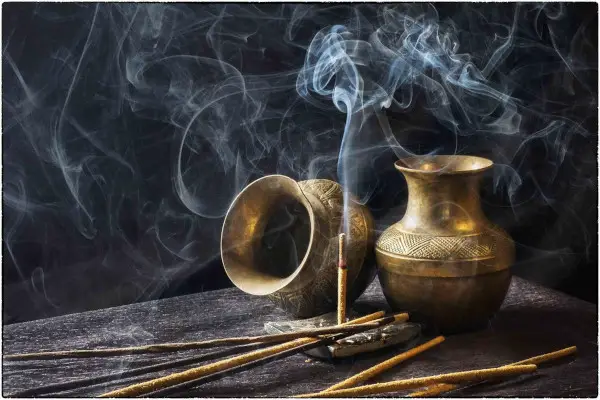
How Often Should You Smudge?
Like anything else, moderation helps, especially with the health implications of too much exposure to burning fumes. Therefore, daily smudging is not recommended. You can smudge your house or home periodically, like once a month or for once for each of the four seasons in a year. Alternatively, you can smudge based on when needs arise for cleansing, or you want a restart. These include;
- When you are getting to a new place
- When you feel your house has had negative vibes for a while
- When you have had negative experiences like quarrels or fights
- To help mark an important positive change like a new healthy habit or ending relations with a toxic person.
Safety First
As this guide points out, there can be dangers to your health if you do not do smudging safely. Here are specific points to observe.
- Use a bowl that can hold up well under the heat so that it does not crack.
- If you are lighting up charcoal pieces, use tongs to avoid burns.
- When smudging, leave the windows open and ensure the room is essentially well ventilated.
- Avoid smudging or do it lightly in the presence of people who could be sensitive to the smoke, including the elderly, children, and those with respiratory problems.
- Avoid fire hazards by ensuring no burning item or flame is left unattended.
- You can leave the ashes in the bowl for the night instead of throwing them away immediately to ensure they are extinguished and not smoldering when you dispose of them.
- To effectively extinguish the smudge stick, push it into dry sand or soil, effectively cutting its oxygen supply and ending the smoldering.
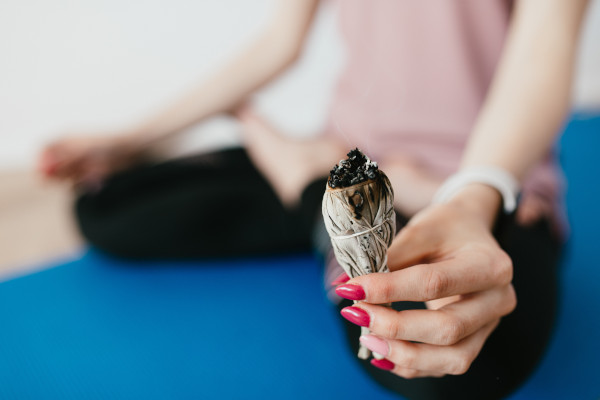
Smudging FAQ
What Is Smudging a House?
It is a way to purify and cleanse a house by driving out negative energy through burning plant material. The smoke from the burning cleanses it and introduces positive energy to the house.
Can You Reuse Smudge Stick?
Yes, you can reuse a smudge stick until there is nothing left to burn. It is usually applicable if you were smudging an object or a small space that leaves a significant amount of the smudge stick unused.
Can Smudging Cause Headaches?
Smudging is generally safe. However, if you do it in poorly ventilated areas or for prolonged periods while inhaling the smoke, it can cause headaches and fatigue.
Can Smudging Help Anxiety?
Yes, smudging can help alleviate your anxieties by relaxing you and improving your mindfulness. It is used as a traditional solution for the relief and management of stress and anxiety.
Can Smudging Cause Cancer?
In cases of extreme use without regarding your safety or those of others, smudging can increase your risk for cancer. This happens of you smudge frequently and for long in poorly ventilated areas.
Can Smudging Cause a Fire?
It is highly unlikely for smudging to result in a fire since you are largely using smoke. If you dispose of the ashes well and do not suffer any unfortunate accident, there is no fire risk.
Can Smudging Be Dangerous?
Yes, if done frequently and over prolonged periods and in poorly ventilated surroundings, smudging can pose health risks. Even a normal setting can be discomforting for children and people with respiratory conditions and allergies.
Is Smudging Religious?
Smudging has its roots in spiritual and religious practices in ancient traditions. While you can use it for practical benefits, it is still a religious ritual for many, whether it is for divination or seeking good fortune, and is accompanied by prayers.
Do You Burn the String When Smudging?
Yes, the string holds the smudge in place, and as long as it is from plant material, it is safe to burn.
What to Say When Smudging a House?
During smudging, you can say mantras or prayers reflecting the intention and purpose of your activity. The mantras also help you stay focussed and mindful in the process.
Should I Shower Before or After Smudging?
There is no requirement, but ideally, if you are cleaning everything before the smudge, you can take a shower too.
Do you want to learn more about Magick? Check out our recommendations at “Magick Bookshelf” and many free resources at our “Free Magick Library“
Stay in Touch
 Join our newsletter by using the forms on this website or click here!
Join our newsletter by using the forms on this website or click here! Follow us on Google News
Follow us on Google News Follow us on Facebook
Follow us on Facebook
Featured image from Depositphotos

